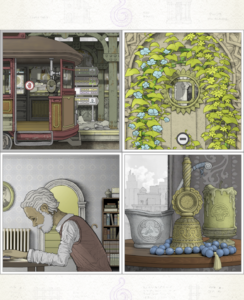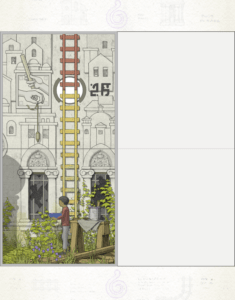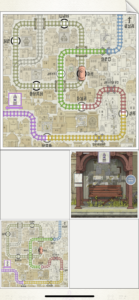Gorogoa
Developed by Jason Roberts and Buried Signal | Published by Annapurna Interactive | Mobile iOS | 2017

This is my first time spending $4.99 on a puzzle game and it was worth every cent. Gorogoa is a beautifully crafted game not only because of its graphics but also its uniquely formatted puzzles. The whole game is contained in four square panels however, the world feels expansive due to the many ways you can progress through the story. Players shift the panels around in the 2×2 square. They can also move within the panels by scrolling with arrows or moving inside of objects. Once you fit together the panels in a certain way, the character is able to progress in the story.
I only planned to play some of the game, but once I started I really wasn’t able to put it down until I solved the whole game. Lucky (and unlucky) for me the game ended about 2 hours later. Gorogoa, to me, seems like a very accessible game because of the smooth controls and the friendly yet mysterious themes. However, I found myself thinking a lot about the mental energy it took to navigate four panels simultaneously. I imagine younger folks may only have capacity to focus on one scene at a time versus navigating 2-4 different panels with 2-3 different scenes. In general, this game is made for people who are not easily overwhelmed by various scenes/settings.

Gorogoa balances the imagination and the use of ordinary objects in its puzzles. For example, we use the train tracks of one panel to use as a ladder when its connected to another panel (photo shown on the left). Or we use a star to light a lantern. As we progress towards the end of the game, we began to see more difficult puzzles that rely on timing where the panels are positioned. However, I enjoyed how this game did not depend on time pressure to make it exciting. There was plenty of time to discover everything needed in the panels and figure out a solution on how to fit the panels together. Lastly, the transitions between puzzles progressed the narrative in a timely manner by revealing important fantastical and realistic elements.
Things that encouraged me to keep playing were the “hint” panels and the many opportunities for trial and error. Even though, at times, I thought the four panels to be overwhelming, some panels just contained resources and hints to help you with other panels. Additionally, depending on what stage you are on, each panel had various amount of clicks. Not every panel needed to be thoroughly searched. Discovery is a huge aspect of the game and I appreciated the efforts to make it not overwhelming.
 A nit-picky logistical thing: I wasn’t fond of the proportions of the 2×2 grid and the zoom in feature was kind of finicky. It was hard to see the details sometimes. To utilize all of the space on a mobile device, I would have liked to play in landscape mode and have the grid fill up the screen. This format makes mobile games a lot more immersive and accessible.
A nit-picky logistical thing: I wasn’t fond of the proportions of the 2×2 grid and the zoom in feature was kind of finicky. It was hard to see the details sometimes. To utilize all of the space on a mobile device, I would have liked to play in landscape mode and have the grid fill up the screen. This format makes mobile games a lot more immersive and accessible.
All in all, highly recommend playing this game at least once — if not for the unique puzzle format, for the beautiful aesthetics!



